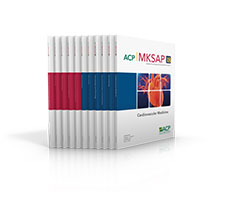 MKSAP has been trusted by internists since 1967 as the best resource for updating knowledge. MKSAP 18, available in Complete, Digital, and Print packages, consists of 11 comprehensive text chapters with related multiple-choice questions. You'll find 1,200 completely new questions to help you identify learning gaps, stay current, and gain the knowledge you need to provide the best possible patient care. MKSAP 18's original and high-quality questions evolve out of case studies and patient scenarios based on the latest evidence.
MKSAP has been trusted by internists since 1967 as the best resource for updating knowledge. MKSAP 18, available in Complete, Digital, and Print packages, consists of 11 comprehensive text chapters with related multiple-choice questions. You'll find 1,200 completely new questions to help you identify learning gaps, stay current, and gain the knowledge you need to provide the best possible patient care. MKSAP 18's original and high-quality questions evolve out of case studies and patient scenarios based on the latest evidence.
For more information on MKSAP 18, or to order your copy, visit mksap18.acponline.org.
MKSAP 18 Q & A
A 66-year-old man is evaluated in the emergency department for chest pain and dyspnea. Three days ago, he experienced the sudden onset of substernal chest pain. His symptoms waxed and waned over a period of 3 hours and then spontaneously subsided. Today, he began experiencing progressive shortness of breath with symptoms occurring at rest. His medical history is significant for hypertension and hyperlipidemia. His medications are hydrochlorothiazide, atenolol, and atorvastatin.
On physical examination, he appears distressed. Temperature is normal, blood pressure is 95/50 mm Hg, pulse rate is 115/min, and respiration rate is 24/min. Oxygen saturation is 90% breathing 4 L of oxygen by nasal cannula. Jugular venous pulse is elevated and visible, with exaggerated x and y descents, and the estimated central venous pressure is 12 cm H2O. Bilateral crackles are noted. A soft, early systolic murmur with an S3 is audible in the apical area. An early diastolic rumble is present.
An electrocardiogram demonstrates significant Q waves in the inferolateral leads and elevated ST segments. A chest radiograph confirms the presence of heart failure with cardiomegaly and bilateral pulmonary edema.
Which of the following is the most likely diagnosis?
A: Aortic stenosis
B: Cardiac tamponade
C: Mitral regurgitation
D: Tricuspid regurgitation
Back to the September 2018 issue of ACP International

